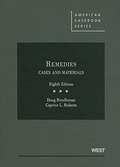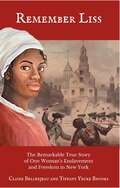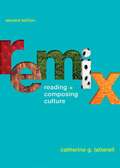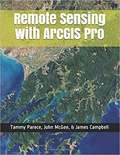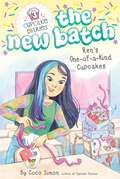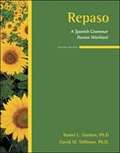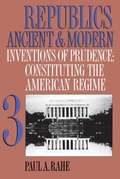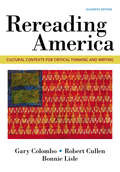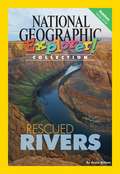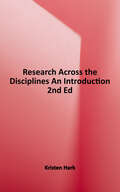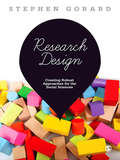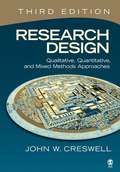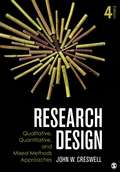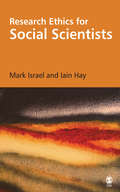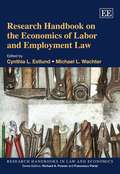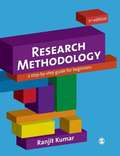- Table View
- List View
Remedies, Cases And Materials, 8th ed.
by Doug Rendleman Caprice L. RobertsRemedies Eighth teaches students how to traverse the complex territory of choice and measurement of plaintiffs remedies. Accessible and readable decisions build on upper-level students first-year courses in contracts, torts, property, constitutional law, and civil procedure. <P> Remedies Eighth is organized to teach students how to choose and measure damages, injunctions, and restitution. It emphasizes the lawyer s tactics in addition to the court s decisions. It examines law and economics in selecting between tort and contract remedies. <P> Remedies Eighth cites and discusses the freshly minted 2011 Restatement (Third) of Restitution and Unjust Enrichment. New decisions in Remedies Eighth examine "actual damages," medical monitoring, the American attorney-fee Rule and the private-attorney-general exception, the Supreme Court s punitive damages opinions in Exxon Shipping Company v. Baker and Philip Morris USA v. Williams, state constitutional limits on damages caps, etc.
Remember Liss: The Remarkable True Story of One Woman's Enslavement and Freedom in New York
by Tiffany Yecke Brooks Claire BellerjeauRemember Liss is the true story of Liss, an enslaved Black woman in 18th century New York whose life sheds light on the experiences of people of color in New York from the colonial period and the Revolutionary War into the early republic. Her life reveals the often-overlooked history of slavery in New York and her involvement with Robert Townsend, a spy for George Washington, engages readers with fascinating stories of espionage. This text also points readers to primary documents and lesson plans through NY Archives' online platform "Consider the Source." Remember Liss offers a new perspective to America's founding, from the point of view of an enslaved Black woman seeking personal liberty in a country fighting for its own.
Remix: Reading and Composing Culture
by Catherine G. LatterellWith a mix of humor and analysis, a collection of fresh readings, lively assignments, and an enticing design, ReMix is not your ordinary textbook. It asks students to re-examine everyday concepts (such as identity, entertainment, and technology); to question assumptions about everyday life and culture; and to respond critically and creatively to some of the most imaginative projects you'll find in a composition reader. Built on the idea that students live in a do-it-yourself world in which they are the writers, designers, and inventors, ReMix invites students to bring their own creativity into the composition classroom. It inspires them to ask: Why do I think the way I do? What is my relationship to the culture around me? Am I truly, as one advertisement claims, "my playlist"? This question-posing approach allows students to write about culture and identity in a meaningful way.
Remote Sensing in ArcGIS® Pro
by Tammy E. Parece James B. Campbell John A. McGeeRemotely sensed images are widely available and have countless potential applications. In the past, analyzing these images required specialized software. Esri’s ArcGIS Pro software includes tools that can be used by novice and experienced analysts. In this manual, we provide a series of easy-to-understand, step-by-step tutorials to guide you through image analysis processes. By completing this series of tutorials, you will be able to: •Manipulate data in ArcGIS Pro •Obtain and display Landsat data •Display image data from Landsat or other remote sensing platforms (including Sentinel and sUAS) •Enhance and analyze remotely sensed imagery.Videos available through the Virginia Geospatial Extension Program’s YouTube Channel can be used as additional resources to accompany this manual.
Ren's One-of-a-Kind Cupcakes (Cupcake Diaries: The New Batch #3)
by Coco SimonRen Lu shows off her creative flair in this third book in the Cupcake Diaries: The New Batch chapter book series, the little sister series to the bestselling Cupcake Diaries. Includes black and white illustrations throughout!From the stylish blue streak in her hair to the fun decorations she designs for the Mini Cupcake Club, Ren Lu is always looking for ways let her creative side shine bright! When Fenton Street School announces their Kindness Week, Ren has the idea to make mini cupcakes for everyone in her grade. After all, what&’s kinder than a cupcake? But when someone else tries to sprinkle in their own ideas, it makes Ren feel a little sour. This is her idea, and she has it all under control…until she doesn&’t. Can Ren learn how to accept some help before her plan falls flat?
Renewable and Nonrenewable Resources: Science 4. 6
by Barbara Phalen Robert KeelerNIMAC-sourced textbook
Repaso: A Spanish Grammar Review Worktext
by Ronni L. Gordon David M. StillmanNIMAC-sourced textbook
Reporteros 1
by Luis Enrique Elías Sharon Ferrer Sonia Josa Evelyn Alizo Fernando Pomar Linda VilladónigaNIMAC-sourced textbook
Reproduction of Organisms (Inspire Science, Grade 6 Integrated #Unit 2)
by Douglas Fisher Ralph M. Feather Alton L. BiggsNIMAC-sourced textbook
Republics Ancient and Modern, Volume I: The Ancien Régime in Classical Greece
by Paul A. RaheWhere many intellectual historians discern a revival of the classical spirit in the political speculation of the age stretching from Machiavelli to Adam Smith, Rahe brings to light a self-conscious repudiation of the theory and practice of ancient self-government and an inclination to restrict the scope of politics, to place greater reliance on institutions than on virtuous restraint, and to give free rein to the human's capacities as a toolmaking animal.
Republics Ancient and Modern, Volume III: Constituting the American Regime
by Paul A. RaheWhere many intellectual historians discern a revival of the classical spirit in the political speculation of the age stretching from Machiavelli to Adam Smith, Rahe brings to light a self-conscious repudiation of the theory and practice of ancient self-government and an inclination to restrict the scope of politics, to place greater reliance on institutions than on virtuous restraint, and to give free rein to the human's capacities as a toolmaking animal.
Rereading America: Cultural Contexts For Critical Thinking And Writing
by Robert Cullen Gary Colombo Bonnie LisleRereading America remains the most widely adopted book of its kind because it works: instructors tell us time and again that they've watched their students grow as critical thinkers and writers as they grapple with cross-curricular readings that not only engage them, but also challenge them to reexamine deeply held cultural assumptions, such as viewing success solely as the result of hard work. <P><P>Extensive apparatus offers students a proven framework for revisiting, revising, or defending those assumptions as students probe the myths underlying them. Rereading America has stayed at the forefront of American culture, contending with cultural myths as they persist, morph, and develop anew.
Resaltar lo negativo: Enteros y números racionales
by Glenda Lappan James T. Fey Susan N. Friel Elizabeth Difanis PhillipsNIMAC-sourced textbook
Rescued: My Story of Survival (Fountas & Pinnell Classroom, Guided Reading Grade 6)
by Suly ChenkinAGAINST IMPOSSIBLE ODDS Suly Chenkin found herself in one of the worst places at one of the worst times in human history. A Jewish child born in Lithuania during World War II, Suly was not likely to survive. Adolf Hitler and the Nazis stormed through Europe determined to destroy the Jewish people. In her memoir, Suly tells her miraculous story of survival. NIMAC-sourced textbook
Research Across the Disciplines: An Introduction
by Kristen HarkDoing research is like being a detective. Both researchers and detectives are trying to find out something. Both are asking and answering questions. Both are trying to put together a puzzle to come up with a solution. In both, answering questions leads to more questions. And, in both, seeing patterns is crucial to solving the puzzle. <p><p>Research Across the Disciplines: An Introduction provides students with information about the foundations of research methods, the choices as scholars make, and the methodological decisions driving to balance the desire to know and inquire into interesting communication questions while instilling enthusiasm about the process.
Research And Evaluation In Counseling
by Bradley ErfordResearch is often an intimidating topic in a counselor training program. This text helps to alleviate students' concerns while helping them learn what they need to know. It presents the most essential components of research and illustrates them with meaningful examples, enabling students to master each component. Recognizing that the profession of counseling has entered the age of accountability, Erford developed RESEARCH AND EVALUATION IN COUNSELING to help educate counselors and future counselors about research and evaluation procedures so that their treatment of clients can be more effective and efficient. Organized into three topical sections, the second edition addresses the curricular requirements of the Council for Accreditation of Counseling and Related Educational Programs (CACREP), providing the latest information on research, statistics, and evaluation procedures.
Research Design: Creating Robust Approaches for the Social Sciences
by Stephen GorardResearch design is of critical importance in social research, despite its relative neglect in many methods resources. Early consideration of design in relation to research questions leads to the elimination or diminution of threats to eventual research claims, by encouraging internal validity and substantially reducing the number of alternative explanations for any finite number of research 'observations'. This new book: discusses the nature of design; gives an introduction to design notation; offers a flexible approach to new designs; looks at a range of standard design models; and presents craft tips for real-life problems and compromises. Most importantly, it provides the rationale for preferring one design over another within any given context. Each section is illustrated with case studies of real work and concludes with suggested readings and topics for discussion in seminars and workshops, making it an ideal textbook for postgraduate research methods courses. Based on the author's teaching on the ESRC Doctoral Training Centre "Masters in Research Methods" at the University of Birmingham, and his ongoing work for the ESRC Researcher Development Initiative, this is an essential text for postgraduate researchers and academics. There is no book like Research Design on the market that addresses all of these issues in an easy to comprehend style, for those who want to design research and make critical judgements about the designs of others.
Research Design: Qualitative, Quantitative, and Mixed Methods Approaches
by John W. CreswellThe Bestselling Text is Completely Updated and Better than Ever Praise for the Third Edition I have used the older edition with great success. The new one is even better. -Kathleen Duncan, "University of La Verne" The Third Edition of the bestselling text Research Design by John W. Creswell enables readers to compare three approaches to research-qualitative, quantitative, and mixed methods-in a single research methods text. The book presents these three approaches side by side within the context of the process of research from the beginning steps of philosophical assumptions to the writing and presenting of research. Written in a user-friendly manner, Creswells text does not rely on technical jargon. He cuts to the core of what a reader needs to know to read and design research in part by showcasing ideas in a scaffold approach so that the reader understands ideas from the simple to the complex. Key updates to the Third Edition Presents the preliminary steps of using philosophical assumptions in the beginning of the book Provides an expanded discussion on ethical issues Emphasizes new Web-based technologies for literature searches Offers updated information about mixed methods research procedures Contains a glossary of terms Highlights research tips throughout the chapters incorporating the author s experiences over the last 35 years.
Research Design: Qualitative, Quantitative, and Mixed Methods Approaches (Fourth Edition)
by John W. CreswellThe eagerly anticipated Fourth Edition of the title that pioneered the comparison of qualitative, quantitative, and mixed methods research design is here! For all three approaches, Creswell includes a preliminary consideration of philosophical assumptions, a review of the literature, an assessment of the use of theory in research approaches, and refl ections about the importance of writing and ethics in scholarly inquiry. He also presents the key elements of the research process, giving specifi c attention to each approach. The Fourth Edition includes extensively revised mixed methods coverage, increased coverage of ethical issues in research, and an expanded emphasis on worldview perspectives.
Research Ethics for Social Scientists
by Iain Hay Mark Israel`This is an excellent book which can be recommended both to the professional ethicist seeking to situate research ethics for a social scientific audience and to social scientists seeking an overview of the current ethical landscape of their discipline' - Research Ethics Review Ethics is becoming an increasingly prominent issue for all researchers across the western world. This comprehensive and accessible guide introduces students to the field and encourages knowledge of research ethics in practice. Research Ethics for Social Scientists sets out to do four things: The first is to demonstrate the practical value of thinking seriously and systematically about what constitutes ethical conduct in social science research. Secondly, the text identifies how and why current regulatory regimes have emerged. Thirdly, it seeks to reveal those practices that have contributed to the adversarial relationships between researchers and regulators. Finally, the book hopes to encourage both parties to develop shared solutions to ethical and regulatory problems. Research Ethics for Social Scientists is an excellent introductory text for students as it: - introduces students to ethical theory and philosophy; - provides practical guidance on what ethical theory means for research practice; - provides case studies to give real examples of ethics in research action. The result is an informative, accessible and practical guide to research ethics for any student or researcher in the social sciences.
Research Handbook On The Economics Of Labor And Employment Law
by Michael L. Wachter Cynthia L. EstlundThis Research Handbook assembles the original work of leading legal and economic scholars, working in a variety of traditions and methodologies, on the economic analysis of labor and employment law. <p><p> In addition to surveying the current state of the art on the economics of labor markets and employment relations, the volume's 16 chapters assess aspects of traditional labor law and union organizing, the law governing the employment contract and termination of employment, employment discrimination and other employer mandates, restrictions on employee mobility, and the forum and remedies for labor and employment claims.
Research Methodology: A Step-By-Step Guide for Beginners (3rd Edition)
by Ranjit KumarThe Third Edition of Research Methodology: A Step-by-Step Guide for Beginners integrates various quantitative and qualitative methodologies into eight practice-based-steps, providing lots of examples throughout to link theory with practice. Written specifically for students with no previous experience of research and research methodology, the writing style is simple and clear and the author presents this complex subject in a straightforward way that empowers readers to tackle research with confidence. The book has been revised and updated to include extended coverage of qualitative research methods in addition to existing comprehensive coverage of quantitative methods. There are also brand new learning features such as reflective questions throughout the text to help students consolidate their knowledge.
